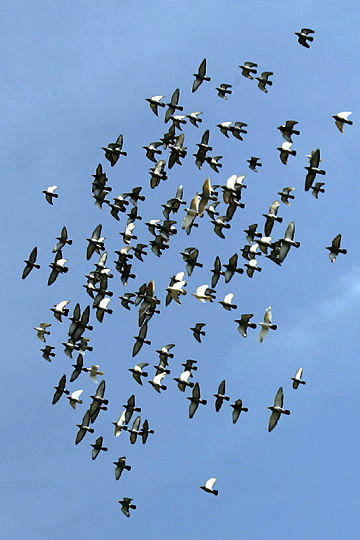
On Saturday I counted birds in my neighborhood for the Pittsburgh Christmas Bird Count on the wettest, rainiest day we’ve had in a very long time. The only birds that moved were crows, starlings and pigeons.
The pigeons caught my attention because they were so hard to count. Just after dawn a flock of two dozen birds began their morning flight routine. They started off slowly but as they warmed up they flew in tighter formation, faster and faster, closer and closer together, changing direction often. I marveled at how well they stayed in sync. They were very hard to count!
At the height of their exercise I noticed the flock changed direction so quickly that the leader must have ended up in the back of the group. How did they do this and still maintain their formation? Who was in charge?
This question has puzzled scientists too, so last year a team in Budapest decided to find out more by attaching GPS backpacks to a flock of domestic homing pigeons. The GPS units recorded the birds’ position every 0.2 seconds as they flew home or wheeled around the neighborhood. The data was then used to plot the birds’ paths and figure out where each bird flew in relationship to the others and how quickly it changed direction in response to the rest of the flock.
The results were quite interesting. The flocks’ leaders almost always fly in the front and the other birds copy the leader’s movements within 0.4 seconds. The low ranking birds fly behind and to the right but leadership can change and even low-ranking birds occasionally get the chance to lead. This confirms my hunch that the leaders end up at the back of the flock sometimes.
Why do the low-ranking birds fly behind and to the right? The researchers’ theory is that this position maximizes their ability to follow the leader. These birds use their left eyes to watch the leader, left-eye information is processed by the right side of the brain, and the right side of the brain is best at quickly handling social responses.
Why does the flock change leadership? How does it hand off leadership so deftly? The study didn’t answer all my questions but it’s a great start. Read more about it here in Science Magazine.
(photo from Wikimedia Commons. Click on the image to see the original)
Very interesting. You may also be interested in this flocking study in American Scientist.
http://www.americanscientist.org/issues/pub/2011/1/flights-of-fancy
We’ve been in Yonkers for a wedding, and so read about the Christmas Bird Count in the NY Times. They were impeded by the 20″ snowfall going on, and so stopped early. They did report a peregrine, and a “duck crow”. We saw some sort of hawk as we drove to Mt. Kisko, perched on a light pole, but we were past it too fast to note anything more.
They were concerned about the absence of grackles? Excuse my ignorance, but I thought they were nuisance birds?
Happy New Year to all
Anne
Really fascinating stuff.
Anne, grackles really are a species of concern. They’ve declined 61% in the past 40 years — mostly because of a misguided (in my opinion) USDA program to poison them. Read more about common species in decline here:
http://birds.audubon.org/species-by-program/cbid